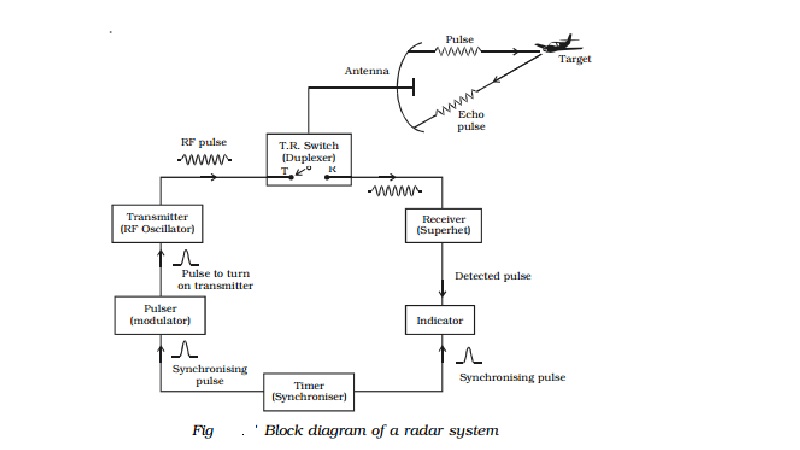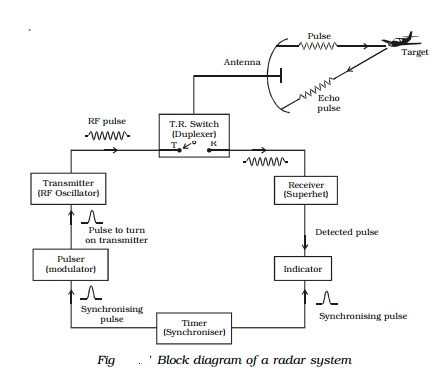Chapter: 11th 12th std standard Class Physics sciense Higher secondary school College Notes
RADAR: Principle, Applications, Transmission and reception of radar

RADAR
The term RADAR is an acronym for RAdio
Detection And Ranging. It is a system which uses radio waves to detect and to
fix the position of targets at a distance.
Principle of radar
Radar works on the principle of 'radio echoes'.
The transmitter in a radar, radiates the high power electrical pulses into
space. When these pulses are incident on any distant target such as a mountain,
ship or aircraft, they get scattered in all directions. The transmitter antenna
receives a part of the scattered energy. This transmitter antenna also acts as
receiving antenna for the receiving pulse. The pulse travels with the speed of
light 3 × 108 ms-1. In other words, these pulses cover a
distance of 300 metres for every micro second. Hence by measuring the time
taken by the pulse to reach the target and back to the transmitter, the range
or distance of the target can be easily determined. To locate the direction of
the target, directional antennas are used.
Transmission and reception of radar
The block diagram of a simple radar system is
shown in Fig This block diagram indicates that the radar system consists
of both the transmitting and the receiving system.

The transmitting system consists of a
transmitter and a pulser. The receiving system consists of a receiver and an
indicator. In most of the cases, a single antenna is used for both transmission
and reception and this is achieved with the use of TR switch (Transmitter
Receiver Switch). This switching arrangement is called as 'duplexer'. This
connects the antenna to the transmitter during transmission and to the receiver
during reception. Moreover, this switch isolates the sensitive receiver from
the damaging effects of the high power transmitter.
The transmitter is essentially a high power
magnetron oscillator which generates high power pulses. This transmitter is
turned on and off with a periodic pulse from the pulser. Thus the transmitter
generates periodic pulses of very short duration. These short pulses are fed to
the antenna which radiates them into the space. The antenna is highly
directional.
If the transmitted pulse hits any target, a
weak echo signal returns to the same antenna. But, now the TR switch puts the
antenna in contact with the receiver. This echo signal is amplified and
demodulated by the superhet receiver. The sensitivity of the receiver is very
high. The detected output is sent to the indicator. The indicator is a cathode
ray tube. The CRT displays the original transmitted pulse as well as the
detected echo pulse along a horizontal base line. The synchronising pulse
generated by the 'timer' is supplied to both transmitting and receiving
systems. So, the indicator records the transmitted pulse as well as the
returning pulse simultaneously. The returning echo pulse appears slightly
displaced from the transmitted pulse and this displacement is a measure of the
range of the target.
Some applications of radar
1.
Air and sea navigation is made entirely safe,
with radar installations. High flying planes and ship at sea, can get detailed
reports of mountains, ice bergs, rivers, lakes, shore lines etc., which they
can avoid.
2.
Radar systems are used for the safe landing of
air crafts. On approaching the air field, the pilot is guided by signals from a
radar set, so that it flies along the line of the runway and lands safely,
whatever be the visibility.
3.
Rain drops may reflect suitable radar signals
and thus enable meteorologists to measure the distance of the clouds, with
great accuracy for forecasting.
4.
The pulses can be used for discovering the
position of buried metals, oils and ores.
Related Topics